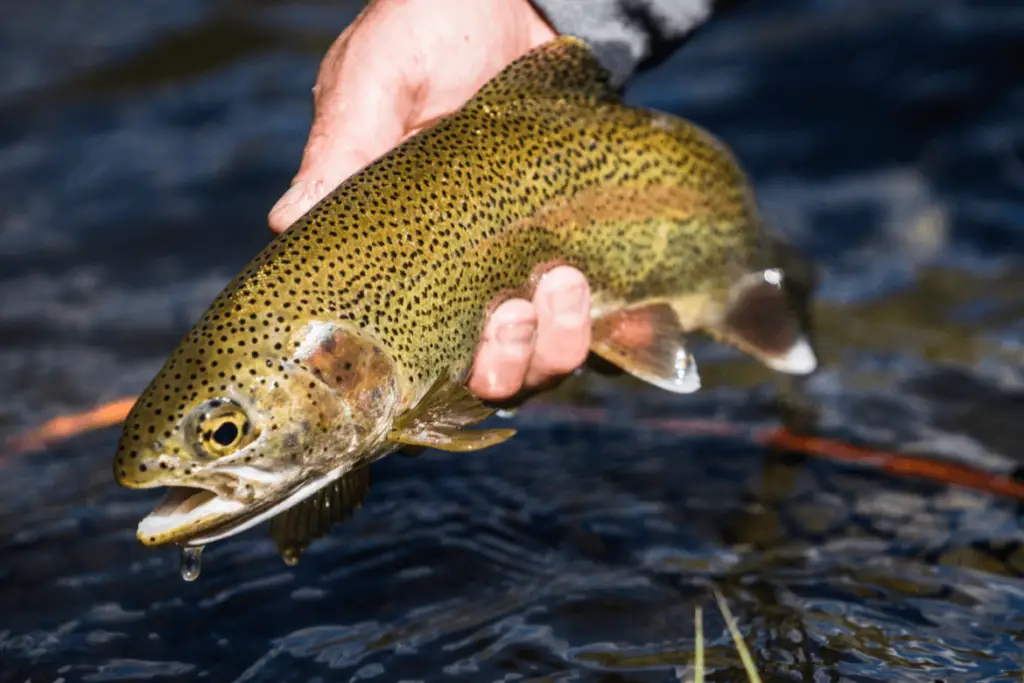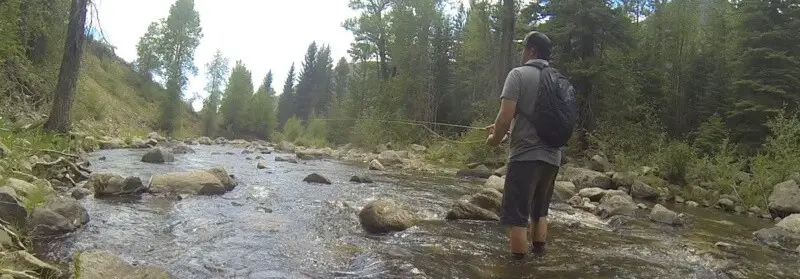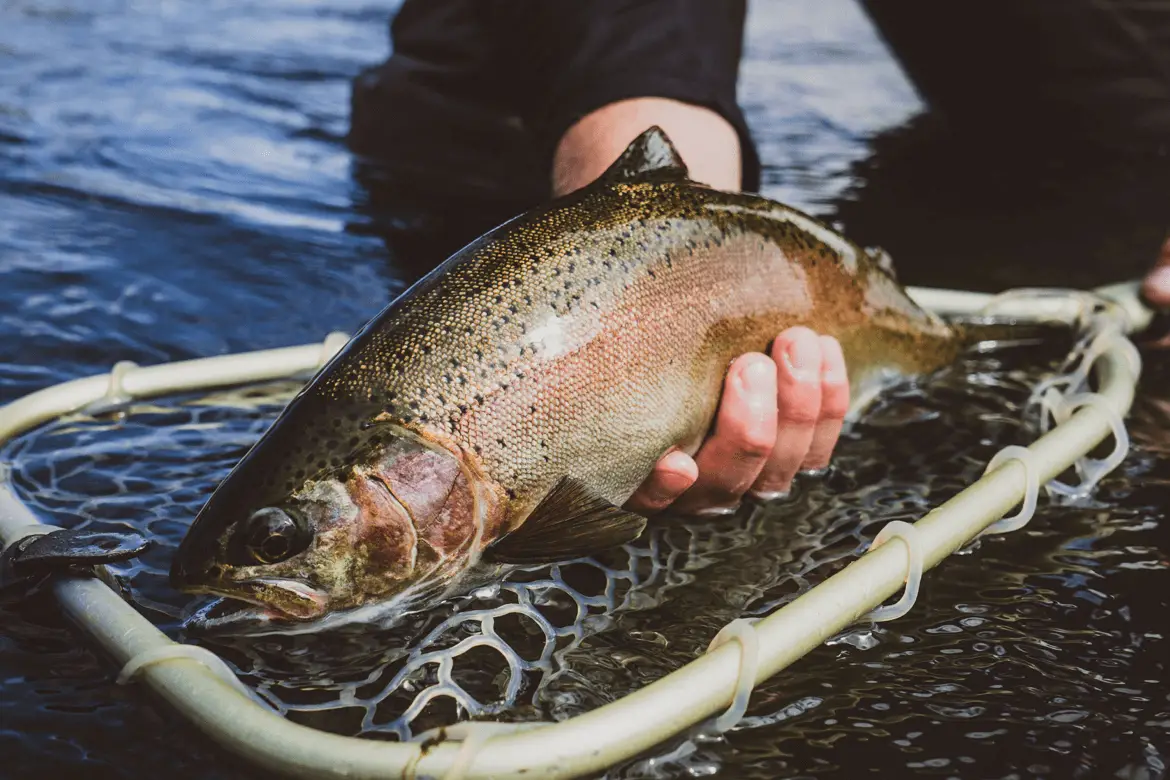Let me know if you have been in this situation – you’re out fishing at a local pond or reservoir, but the trout aren’t biting and are nowhere to be found. After a while you ask yourself the question, ‘why am I not catching any fish?’
This is something that every angler has experienced. This not only happens to beginners, but even the most skill anglers can have a hard time finding and catching fish on a given day.
In this article I’ll share with you the main reasons why you aren’t catching and trout and give you some tips and tricks I’ve learned over the years to help you catch more fish on your next fishing trip.
Let’s get started.
15 REASONS WHY YOU’RE NOT CATCHING TROUT (AND WHAT TO DO INSTEAD)
If you have been fishing for a long time like I have you have probably made a ton of mistakes over the years that have helped become a better angler and catch more fish.
Here are 15 common mistakes that I see anglers make that are preventing them from catching trout.
1. AT THE WRONG SPOT
One of the most common mistakes anglers of all skill levels make is spending way too much time fishing at the same spot. There is a saying in fishing that goes something like this: 90 percent of the fish are in 10 percent of the water.
If you aren’t catching any trout, then you are probably fishing at the wrong area or depth. I would recommend only fishing the same spot for about 30-45 minutes. If you haven’t gotten bit by then it’s time to move on and fish some new water.
One of the keys in fishing is to be constantly on the move until you can find fish. Once you find them, then you can slow down and take your time fishing that area, but don’t waste time fishing in spots that aren’t holding any fish.
2. USING THE WRONG LURE OR BAIT
If you are fishing at a productive fishing spot and are seeing other anglers having success the odds are you are using the wrong type of bait, lure or technique.
One of the great things about fishing is its always a puzzle you have to figure out and what worked yesterday or last week may not work today. That’s why it’s important to mix it up.
After you have been using the same bait or lure for a while and you aren’t having any luck, don’t be afraid to switch it up. Do this until you can find what the fish are wanting and will respond to.
Don’t make the mistake of sticking with a certain lure or technique for too long. If you aren’t catching anything, it’s time to change what you are doing. The fish will tell they want; you’ll just have to experiment until you can find out what that is.
3. FISHING WITH THE WRONG COLORS & PATTERNS
The color or pattern of your lure, fly or bait may not seem like that big of deal, but at times it can have a big impact on your overall fishing success.
There have been times when I have been fishing the exact same lure or bait as someone else, but just in a different color and was out fished by a long shot. Your color can make all the difference sometimes.
If you have been throwing the same color or pattern for a while and haven’t had any strikes, try switching to a different one.
In clear water situations I like to fish natural colors such as greens and browns. In murky or stained water I prefer bright or dark colors.
If you want to learn more about how to choose the right color for each fishing situation check this article ‘Best Colors for Trout Lures’ for more insight.
4. BAD TIMING
It’s no secret there are certain times and seasons where the trout fishing is much better than others. I am a firm believe with the right knowledge, skill and patience you can catch fish any time. However, there is no denying fishing during certain times can make things a lot easier.
If you are struggling to catch trout try you might be fishing at the wrong time of day. In general, the best time to go fishing for trout is during the low light hours (morning, evening and overcast conditions).
Fishing during these “primetime” hours will give you the best chance at catching a bunch of fish. They are much more active, will feed more and will be a lot more willing to bite.
For more insight on the best times to go fishing check out this article I wrote: When is the Best Time to go Fishing?
5. YOUR SPOOKING FISH
Another common reason why many anglers don’t have success catching any trout is because they are too loud and end up spooking the fish away. The moment a fish can feel or hear you coming the harder it’s going to be to be able to trick them into biting.
Anglers will often miss out on some incredible fishing opportunities because they weren’t careful and quiet enough as they approach and fish their spots.
Everyone has either said or heard, “be quiet or you will scare the fish away.” It’s true that fish can feel movement, vibrations, and noises that will cause them to spook. Once this happens the only thing you can do is just move on and come back later.
Trout can feel movement, vibration and noises and even the slightest sound might spook them away. It’s best to be as quite as possible. Try and sneak up to your next fishing spot and don’t be surprised if you end up catching more trout.
6. FISHING AT THE WRONG PLACES
Another possible reason why you may be struggling to catch trout is that you are fishing at the wrong places. Not all fishing destinations are created equal and where you are fishing at may not have a healthy trout population.
There are some lakes, rivers, streams and ponds that are just simply better than others. Do some online research and find out more information about the body of water you are fishing and if it’s common to catch trout there.
If you have fished a particular place a few times and aren’t having any luck don’t be afraid to try a new lake or fishing spot. Each state has a fishing website where you can find fishing reports and information on the best fishing destinations near you.

7. USING WRONG SPEED OR TECHNIQUE
If you are having a hard time catching trout don’t overlook your retrieval speed and fishing technique. The way you present and work you bait, lure and flies can make a huge difference.
The right retrieval speed, drift, cadence and technique will vary depending upon the fishing method you are using.
If you are fly fishing or using bait getting good drifts and presenting your flies and baits naturally will give you the best chance to catch trout.
When fishing with lures speed and cadence can be a huge factor. Fishing too fast won’t allow the fish to get good look at your lure, preventing them from striking. On the other hand, fishing too slow won’t allow you to cover enough water or properly imitate the fishes forage.
Here are a few tips that I’ve learned on when to slow down or speed up:
Slow Down – When fish are extra finicky and sluggish, slowing down your retrieval speed is a great way to catch more fish. Most trout will become sluggish and not as active during the winter/summer months and will prefer a slower presentation.
Speed Up – When water temperatures are high and the fish are more active it may be more beneficial to work your lures fast. This will allow you to fish more water and catch those more aggressive fish.
Tip: mixing up your retrieval speeds on a given cast and adding a few twitches or jerks to your rod is an excellent way to trigger more bites.
8. FISHING AT THE WRONG DEPTH
If the trout aren’t biting a common reason might be that you are fishing at the wrong depth. Trout will prefer to be at certain depths throughout the year which can be influenced by seasonal patterns, time of day and weather conditions.
In general, trout are most comfortable in deep cooler water but they can be found up shallow during the spring. However, their preferred depth may vary lake to lake and other factors may influence their location as well.
Understanding and knowing what depth the trout are going to be at and where you should be fishing will improve your success rate dramatically. That’s why having a fish finder can give you a huge edge.
If you aren’t sure if they are shallow or deep, move around until you can find a fish or two. Once you have success at a certain depth try and replicate in similar areas. You’ll be able to develop a pattern and will end up catching a lot of fish.
9. USING THE WRONG SIZE
Another common reason why many anglers can’t catch any trout is because they are fishing with the wrong size of lure, bait or fly. Size can play a huge role in determining your overall fishing success.
Using an oversized lure for your lake or pond can dramatically decrease your chances of catching trout. It is true that bigger baits catch bigger fish, but if you’re not having any luck downsizing can result in a lot more strikes. Smaller lures and baits will help you catch a lot more fish.
On the other hand, if you’re catching a lot of small ones and want to target bigger trout, don’t be afraid go with a larger size. This will help keep away the smaller ones and make your offering more appealing for the bigger fish.
Matching the hatch is also extremely important to keep in mind. If the trout are targeting smaller flies or baitfish, use baits that closely imitate what they are feeding on. This can increase your odds at catching more fish.
10. USING THE WRONG SIZE
Water temperature is another factor that can determine how active the fish are going to be or not. If water temperatures are extreme their activity level, when they eat, and how aggressive they are can be impacted.
If the trout aren’t biting it may just be too cold or too hot for the for the trout, you are targeting. Or you may just need to slow down your presentation and cast directly on them so that it doesn’t take a lot of energy for them to grab your lure.
11. THE THERMOCLINE
If you are having a hard time catching trout in the summer and winter months, the thermocline might be the reason.
Throughout the year and especially during the winter and summer months there are layers in the water that have different temperatures and oxygen levels.
The thermocline is basically the ideal zone where the water temps and oxygen levels are optimal for the fish. Anything outside of the zone, above or below are zones where the water temperatures are too high and or the oxygen levels are too low.
This causes the fish to move toward the thermocline zone where they will be the most comfortable. This is the zone you want to be fishing and anything outside of this area likely won’t have any fish.
Here is some more information about understanding and finding the thermocline: How to Find the Thermocline. With a fish finder you can find and use this information to your advantage and target trout in the thermocline.
12. COLD FRONTS
Weather is always a wild card when it comes to fishing and a cold front can be an angler’s worst nightmare. Fishing can get really tough during certain weather changes and cold fronts.
A cold front is a basically a transition zone where cold air is replacing warmer air resulting in significant temperature changes. This temperature drop usually has a negative impact on fishing for most species.
Trout tend do shutdown during these periods and become tough to catch. The fishing definitely gets harder, but it’s not impossible to catch fish by any means.
In these situations, try using smaller lures, fish deeper and tight to cover and slow down your overall retrieval. These will help you catch more fish even when faced with tough fishing conditions.
13. CASTING
A big reason why some anglers are unable to catch trout consistently is because they are not making the right type of casts.
Casting distance and accuracy can play a major role in your overall trout fishing success. Longer casts will allow your lure to be in the strike zone longer making it more likely for a trout to come by and strike.

Long casts are especially important when fishing in clear water. You’ll be less likely to spook the fish and can increase your catch rate substantially.
If you are struggling to make accurate and long casts check out these basic tips. You’ll notice a big difference in how many fish you catch when you get you casts dialed in.
14. NOT RESEARCHING AHEAD OF TIME
We have all heard the phrase “failing to prepare is preparing to fail” and in fishing this statement is absolutely true. Being prepared for the body of water and the type of fish you are targeting is extremely important.
Before heading out on your next fishing trip, do yourself a favor and find out as much information as you can before you even get to the water.
Understanding things like seasonal patterns, water levels, flows, water clarity, weather, and what the natural fish forage is can give you a huge advantage.
These days there is a ton of great online resources that can help you prepare ahead of time.
DWR & Other Websites – there are plenty of great DWR websites that provide detailed fishing reports and information in each state. Make sure to frequently check out these resources they will provide you with a great starting point.
Google Earth – Is a great resource that can help you tremendously when scouting out your next fishing spot. It allows you to look at detailed maps of any type of water ahead of time making planning a breeze.
Navionics Web App – the Navionics web app is another great tool that shows you a ton of different lake maps with contour lines, helping you scout out some key spots ahead of time.
YouTube – YouTube is another great resources to utilize and learn from. There are plenty of channels dedicated to trout fishing. This will help keep your skills sharp and stay ahead of the game.
15. NOT USING THE RIGHT GEAR
Not using or having the right gear for the type of fish and body of water you are fishing can be a big reason why you aren’t catching any trout.
Just like in any sport having the right equipment for the task is extremely important. The right gear will not only help you be a more productive angler but it will also keep you and the fish safe.
I’m not advocating you spend thousands of dollars on a fishing equipment by any means, but it is important that you get a quality setup for your chosen fishing method.
It will be well worth the initial investment and will help you better enjoy your fishing experience.
OTHER TROUT FISHING RESOURCES
- Fly Fishing & Not Catching Fish? Here’s 10 Reasons Why
- 20 Trout Fishing Tips to Catch More Fish
- How to Catch Trout: A Complete Beginners Guide
- The 7 Best Ways to Catch Trout
- Catch More Brown Trout with These 7 Lures
BOTTOM LINE
Let’s be honest – Nobody likes spending the entire day out fishing only to come home without any luck. This is especially true if you are fishing with young anglers and family members.
However, by utilizing these fishing tips you’ll be able to identity some common mistakes to avoid and some simple tips you can use that will help you catch more fish.
I hope you have found this article to be insightful and that you apply these tips the next time you are faced with tough trout fishing conditions.
Best of luck out there.

